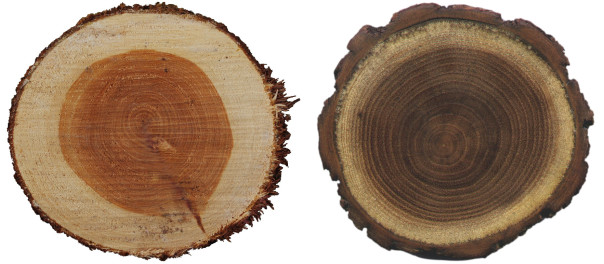Until recently, I didn’t realise that there was more than one type of wood inside a tree. The difference was brought to my attention by Earth Science Photo of the Day‘s photo from April 4th.
 Source: David K. Lynch
Source: David K. Lynch
The photograph above shows a cross-section through a branch from an ebony tree. The heartwood in the centre is what we traditionally think of as being ebony – almost dark black in colour, whilst the sapwood surrounding it is the more “usual” pale brown colour.
All wood begins as sapwood, and it is sapwood that grows just under the surface of the bark, forming growth rings in the process. Sapwood, as its name suggests, carries sap (transported in tubes called xylem) which the tree uses to store and transport water, sugars (maple syrup is made by reducing xylem sap from maple trees to concentrate the sugars), hormones and nutrients.
In young trees all wood is sapwood, but in older trees, as the tree grows in diameter, less cross-sectional area is required for the transport of sap, and greater structural support is required to keep the tree upright. The sapwood in the centre of the tree dies, forming heartwood, and as the cells die they release chemicals that change the colour of the wood, as well as making the wood stronger and more resistant to attack by insects.

The ratio of sapwood to heartwood depends on how many leaves the tree has and how fast it grows: more leaves and faster growth require more water and therefore more sapwood, and not all trees form any heartwood at all. In the photograph above, a cross-section of a maple tree is on the left and a cross-section of a black locust tree on the right: maple trees have very large leaves, and the black locust trees have small leaves, hence the very obvious difference in their sapwood to heartwood ratios.
One thought on “Sapwood and Heartwood”